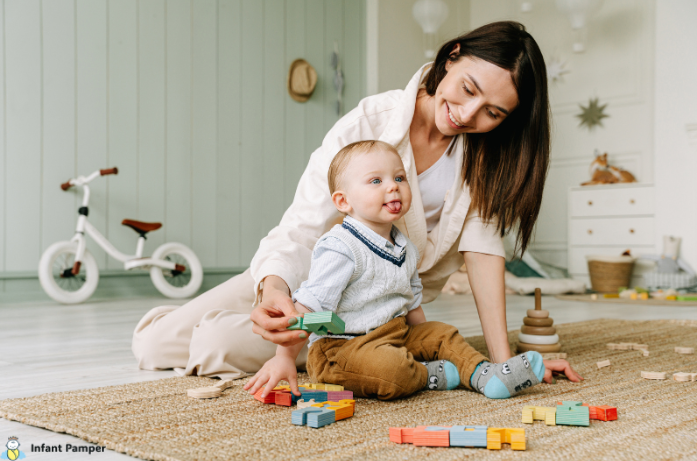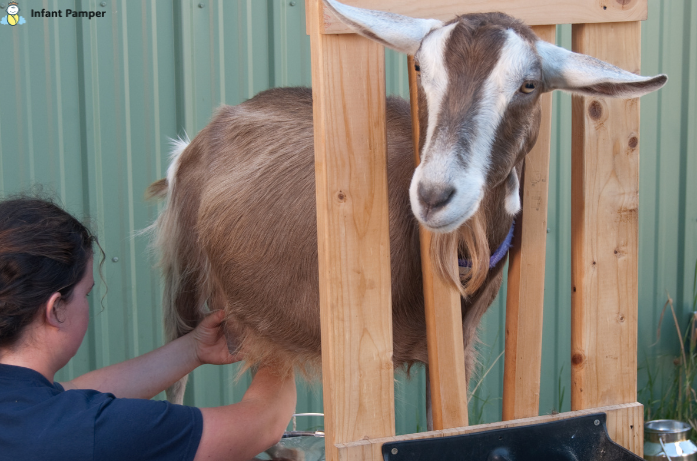By a Caring Mom at Infant Pamper
Baby language development activities are one of the most joyful ways to nurture your child’s communication from the very beginning. From coos and babbles to that first “mama,” every sound builds the foundation for speech and understanding.
At Infant Pamper, our philosophy is that any time can serve as a good opportunity for fostering your baby’s language development. Below we will list and explain seven simple yet effective activities for language development in babies that parents and caregivers can do to nurture early speech development and help build strong baby communication skills from the start.
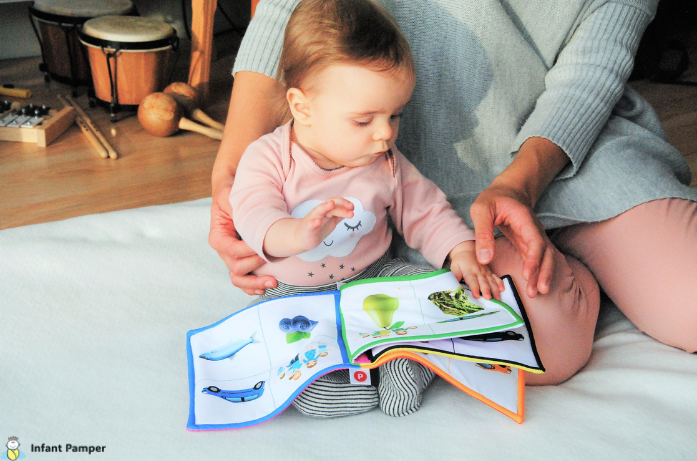
1. Read Aloud Every Day with Expressive Voice and Repetition
From the first months of life, reading to babies for language development creates a sturdy foundation for the learning of a language. Although she may not really understand the words just yet, she absorbs all the intonation of your voice, the organization of sentences, and even the emotions that flow through the story.
Books with colorful pictures, phrases repeated over and over, and soft themes should be the ones you will be using. Babies especially love to hear the same book over and over; it grounds them and aids memory. Let them hold the book, turn pages, or point to pictures. Name objects as you go and pause for your baby’s reactions.
With classics like Goodnight Moon by Margaret Wise Brown or Brown Bear, Brown Bear, What Do You See? by Bill Martin Jr., a baby is well prepared. One can also try First 100 Words by Roger Priddy for vocabulary building.
A bedtime reading routine of 10 to 15 minutes, every night, builds not only comprehension but also emotional bonding and soothing comfort that support speech and language development in infants.

2. Sing Nursery Rhymes and Use Music to Teach Baby Language Development Activities
Besides those casual moments that just happen to be fun, these songs also act as tools for speech and language development during infancy. Repetitive tunes and rhymes expose the infant to sounds, aid in memory formation, and demonstrate the rhythm of language. Alongside songs like Twinkle Twinkle Little Star or The Wheels on the Bus, babies learn to anticipate, which is crucial to learning speech patterns.
Adding hand motions, finger play, or engaging in clap-along games while singing activates more than one sense simultaneously. When you bounce your baby to the beats, you are creating a linkage between movement and sound, thereby building both motor skills and listening skills.
With such gestures, every song turns into a fun learning journey. Allowing a song to play while going about daily chores like diapering, bathing, or even just being in the car makes learning light and fun. These repeated warm moments cement an atmosphere where the little one feels secure and connected from within. Over time, such rituals nurture baby language development and vocabulary, giving a magic touch to early speech development.
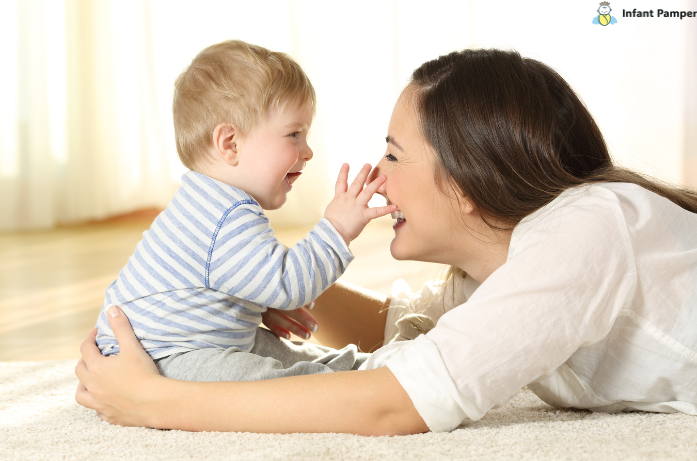
3. Introduce Baby Sign Language to Support Early Communication
You might think of simple games such as peekaboo or pat-a-cake or “Where’s your nose?” as being purely for entertainment, but they have a huge array of educational strengths. That is to say, they help infants develop communication skills such as the back-and-forth rhythm of conversation, waiting for their turn, and reading facial expressions.
Peekaboo introduces object permanence; that is, something exists beyond the sight of a small baby. Using an exaggerated voice and repetition to say, “Where’s the baby? There you are!” sets examples of speech patterns that babies love to imitate.
Games like these encourage gestures, babbling, or laughter, early signs of expressive language learning. If such games become daily rituals, they ensure that what would have been ordinary playtime turns into a language-rich environment for babies, promoting early communication and emotional bonding.
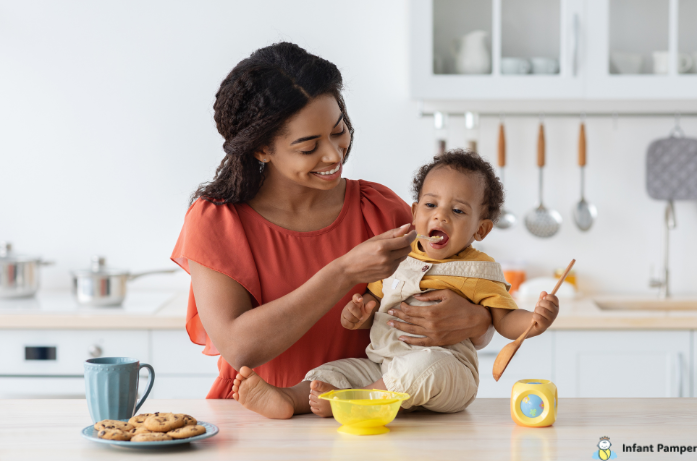
4. Describe Daily Activities with Clear and Repetitive Language
Some babies want to express themselves before they have any words. Baby sign language for early communication provides a way for them to communicate basic needs such as hunger, tiredness, or “more.” This early communication paves the road toward reduced frustration and increased independence and self-confidence.
Make sure you are clear with speech, repeat important words, and point to the objects named. For instance, one would say, “We’re putting on your socks. One sock, two socks!” or “Look at the blue sky. I see a bird. Tweet tweet!” Small conversations such as these help infants link sounds, objects, and actions.
Over time, this experience helps babies associate words with people, objects, and feelings. The more language they hear in context, the faster they learn. Narrating daily activities turns ordinary routines into language stimulation and loving, teachable moments shared by you and your baby, as encouraged by the American Academy of Pediatrics (AAP).
5. Encourage Two-Way “Conversations” Even Before Words Come
Babies love to babble, and your response can be very powerful. Whenever your baby lets loose some form of babble, anything that sounds like “ba-ba” or “ga-ga”, treat it like a real conversation. Smile, use eye contact, and respond with enthusiasm. For example, when your baby says, “Ba ba ba,” say, “Yes! That’s your ball. It’s a big red ball!”
In communication theory, these exchanges are called serve and return communication, and they are among the best ways to nurture baby communication skills and language milestones. This teaches babies that their sounds and actions are meaningful and encourages them to try more words and sounds.
Before uttering their first cry, little ones already learn that it really is a conversation involving listening, reaction, and connection. Answering a baby’s little noises with patience and love helps them feel acknowledged and valued, two things critical for forming confident communicators.
6. Create a Language-Rich Environment with Visual and Verbal Cues
A language-rich environment for babies gives your baby opportunities to hear and learn new words every day. Place in the nursery or playroom simple posters portraying animals, colors, or family photos labeled with names. Keep pointing at them when you play with your baby or during other activities so they can connect words to the world around them.
Encourage your baby to interact with books freely, even if they are just flipping pages or using the book as a teething aid. Provide toys of various textures and sounds, some of which you can name yourself. Mealtimes are another great opportunity to name foods, utensils, and feelings: “Are you hungry? This banana is yummy!”
Try to maintain an ambiance with little interference such as background TV or constant music so your baby gets to hear your voice, which is the most important language learning tool for them. In a rich verbal and visual environment, they grow curious and confident as early speech thinkers.
7. Watch for Developmental Milestones
Keep an eye on general speech and language milestones by age. Here are some typical ones:
| Age | Language Milestones |
| 3 Months | Coos, smiles at voice |
| 6 Months | Babbles, responds to name |
| 9 Months | Understands “no”, uses simple gestures |
| 12 Months | Says “mama”, “dada”, tries words |
| 18 Months | Says several words, points to things |
| 24 Months | Combines 2-word phrases, 50+ words |
If your baby isn’t meeting expected milestones, talk to a pediatrician or licensed speech-language pathologist. Early support can make a big difference.
For trusted developmental milestone charts and checklists, see the CDC’s Learn the Signs. Act Early. milestone pages
Final Thoughts: Your Voice Is the Most Powerful Learning Tool
The language development process shouldn’t be complicated. Your baby doesn’t need apps or flashcards or high-tech toys; they need you, the magic of your voice, attention, and loving presence.
The everyday activities for language development in babies, reading, singing, playing games, and having conversations, give them the confidence and vocabulary they’ll need to communicate well.
FAQs
Q.1 When should I start talking to my baby?
Right from birth. Babies begin absorbing language through your voice immediately.
Q.2 Does reading aloud really help babies learn to talk?
Yes, if done every day, reading will expand vocabulary, listening ability, and comprehension.
Q.3 Can Baby Sign Language delay speech development?
No, it actually fast-tracks the child’s ability to communicate, minimizing any frustration.
Q.4 How many words should my baby say by age one?
About one to three words, clearly.
Q.5 Is screen time a good way for babies to learn language?
Before the age of 18 months, interactions that involve actual people are more effective than those that involve screens.
Disclaimer: This article is for general information only. If you’re concerned about your child’s speech or hearing development, consult a pediatrician or speech-language pathologist for guidance.
Infant Pamper is dedicated to helping parents support their children’s growth with evidence-based guidance, heartwarming encouragement, and simple, joyful routines that make parenting easier and more meaningful.
